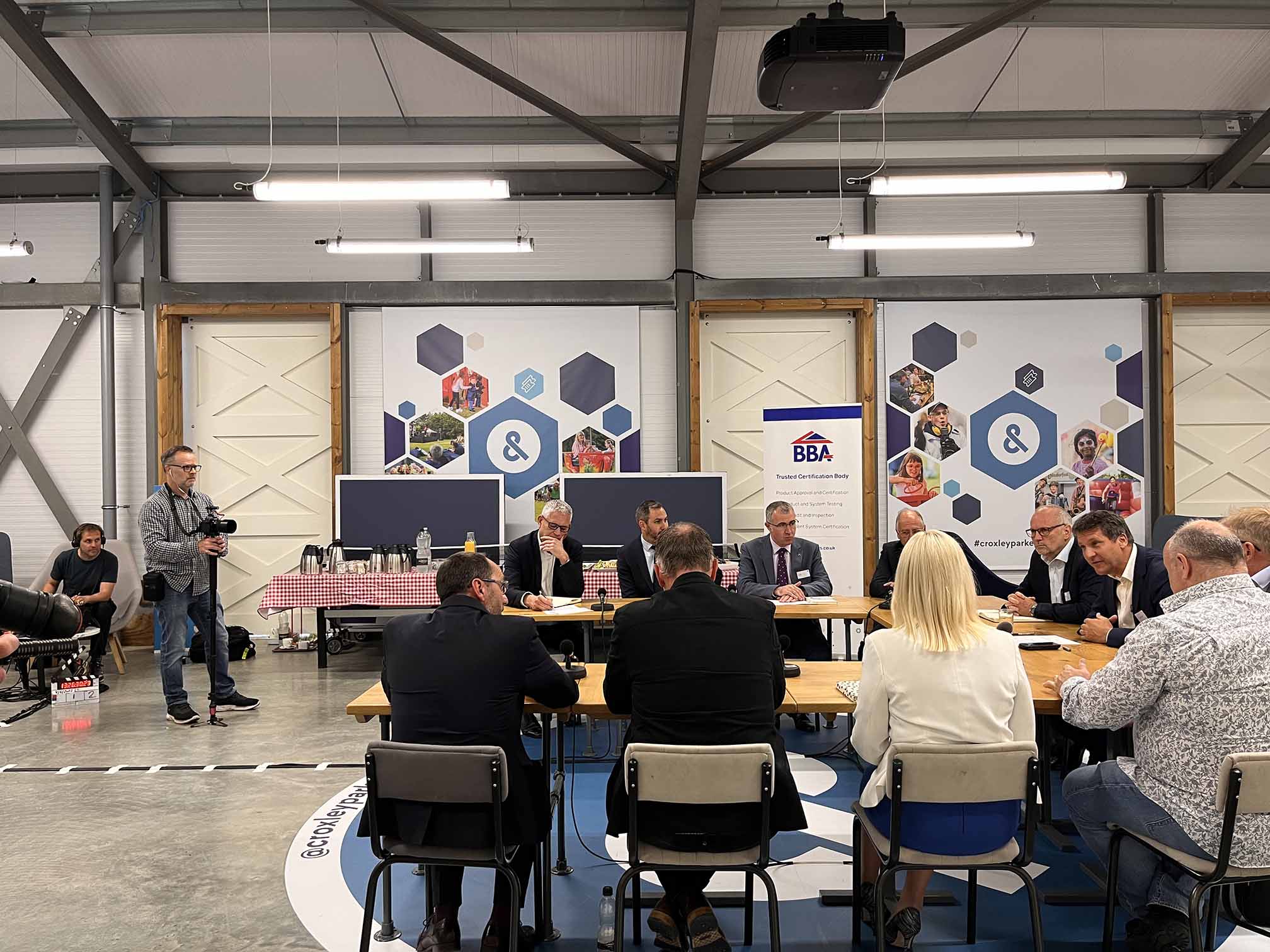As an industry, where are we in terms of utilising new technology or techniques to progress, and do we have the capabilities to capitalise on its potential?
As an industry, where are we in terms of utilising new technology or techniques to progress, and do we have the capabilities to capitalise on its potential?
Speaking at the BBA’s Round Table discussion, Hardy Giesler BBA Chief Executive Officer, Richard Waterhouse BBA Non-Executive Director, Craig Smith Industry Lead / Convenor of City & Guilds, Jason Cureton Founder of Insulfix Ltd, David Johnson Technical Director of DGuage Ltd, Colin Johnson Managing Director of DGuage Ltd, Richard Smith Head of Products & Innovation of NHBC, Adam Turk Chief Executive Officer of Siderise Group Ltd, Antony Brophy Director of Business Development UK at CoBuilder and Emma Wiles BBA Sales & Marketing Director, shared their views.
Watch Part 1 of 5: BBA Roundtable – Adopting new tech in Construction
Richard Waterhouse, BBA:
“I think the industry is very well-positioned to improve – to make advances in both technology and in the ways we systemise construction. Obviously, over the last few years, we’ve been tested quite heavily by Covid, and we’ve seen and learnt things we’ve never expected from that. For example, having fewer people on a construction site actually improved productivity because people weren’t getting in the way of each other. I think we have to re-think how we deliver construction. We have lots of opportunities for doing that: modularisation, off-site construction etc. But underpinning all of this is a change of our culture. And that’s where we still have a problem. We have lots of technology to help with information management. We have innovative products and systems, but we have to have the desire to change”
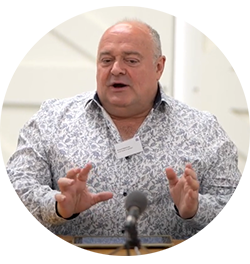
David Johnson: DGuage
“Listening to what Richard said, I can totally go with Risk being one of our biggest problems. My experience is that we are, as an industry, becoming more risk averse. Possibly because we’re more aware of the consequence of failure for example. I’ve always found, particular within my own industry, there is the desire to be the second person to introduce something new, rather than the first. And that always makes it a bit difficult because if you’re not first, who will be? Our issue is how do we tackle the risk aversion in industry?”

Antony Brophy: CoBuilder
“From my perspective, a lot of the drivers are around behavioural changes. There are a lot of people who don’t want to change. I suspect a lot of the drivers will be legislation. People aren’t willing to develop new things at the moment, they’re waiting to be led. Things like the Construction Playbook, the Building Safety Bill, are drivers where people are being mandated to change. Technology, from my perspective and in my field, is about being data-driven and data-led as an approach to making decisions. I think what we’re dealing with now is how do we communicate what is what. What am I describing vs what do you hear? Sometimes what I’m describing may not be what you hear. What we need is a common language for construction. “
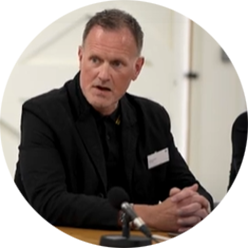
Emma Wiles: BBA
“My background in rail shows that as an industry there are similarities between the rail industry and construction in terms of old processes, embedded processes and culture, that also need to be tackled alongside technology. So, there is trust needed in technology and if you have a sector that doesn’t trust or understand it, it makes it really difficult for technology to become embedded into the sector naturally and takes a lot of time; not to mention other prohibitive factors like cost. Rail has started to make those changes and use technology to its advantage that something Construction can learn from.”
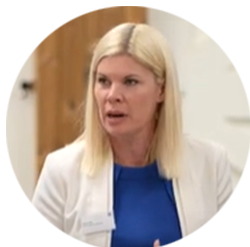
Craig Smith: City & Guilds
“It’s interesting. From a sustainability point of view, we’re seeing a stronger drive around embedding sustainability through qualifications, apprenticeships etc. Across the industry, there’s a lot of people who have risen in the ranks over the years in leadership positions where many have the right hard skills, but may be lacking in softer skills. So, further up in organisations there’s a need for things like leadership skills, further down there’s a need for self-management and readiness for change. So I think the question we need to think about is how we help leaders through this change, but also further down in the organisation how we help people help themselves and be ready for change.”
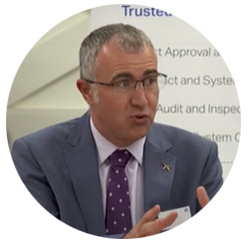
Richard Smith: NHBC
“From a builder point of view, we’re seeing builders charter different technologies in construction to build better and more efficiently and be ready for the future, which is really encouraging. The challenge with technology is making sure that those technologies are fit and appropriate for use and that the end user is not going to be the guinea pig in that technology trial. That’s something we feel really strongly about.”

Colin Johnson: DGuage
“I want to pick up on the idea of technology being a theme, as opposed to being a tool. I think there’s often confusion between the two, when implementing new processes which are inevitably associated with cost. I think from our perspective, its about defining what we’re trying to do with technology: are we trying to digitise or capture more data? Once we understand that, we then put it to the team to figure out the best practice to use. We need to be clear on what we’re trying to achieve. Are we trying to save cost? Trying to demonstrate something else? Often cost becomes the main driver in a business – but if a business has a theme, eg to be more transparent, or more sustainable, while it may have a higher cost implication, it delivers more value.”
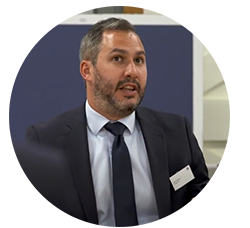
Adam Turk: Siderise Group
“If you ask where we are in terms of utilising new technology, I think there’s a lot of new fantastic technology out there. The construction industry has always been very very poor at the growth stage of a product lifecycle. It gets great innovation, lots of early adopters. The big names get around it and can see the benefit. The industry is very fragmented. We have lots and lots of small companies, SME, involved in construction. To get that wider group to take technology on board, so that we can start to become more mature, is much harder. During that stage, you’ll see lots of confusion; the VHS vs BETAMAX because everyone sees the opportunity before the innovation has become mature. I think they are the things that we need to work on. That and better communications, better pulling in the fragmented base. I think we have to accept it’s not as much about the innovation itself, it’s about the adoption of that innovation, about training, competence, spreading the message that gets everyone on board.”

Share This Story, Choose Your Platform!
Related Roundtables
As an industry, where are we in terms of utilising new technology or techniques to progress, and do we have the capabilities to capitalise on its potential?
As an industry, where are we in terms of utilising new technology or techniques to progress, and do we have the capabilities to capitalise on its potential?
Speaking at the BBA’s Round Table discussion, Hardy Giesler BBA Chief Executive Officer, Richard Waterhouse BBA Non-Executive Director, Craig Smith Industry Lead / Convenor of City & Guilds, Jason Cureton Founder of Insulfix Ltd, David Johnson Technical Director of DGuage Ltd, Colin Johnson Managing Director of DGuage Ltd, Richard Smith Head of Products & Innovation of NHBC, Adam Turk Chief Executive Officer of Siderise Group Ltd, Antony Brophy Director of Business Development UK at CoBuilder and Emma Wiles BBA Sales & Marketing Director, shared their views.
Watch Part 1 of 5: BBA Roundtable – Adopting new tech in Construction
Richard Waterhouse, BBA:
“I think the industry is very well-positioned to improve – to make advances in both technology and in the ways we systemise construction. Obviously, over the last few years, we’ve been tested quite heavily by Covid, and we’ve seen and learnt things we’ve never expected from that. For example, having fewer people on a construction site actually improved productivity because people weren’t getting in the way of each other. I think we have to re-think how we deliver construction. We have lots of opportunities for doing that: modularisation, off-site construction etc. But underpinning all of this is a change of our culture. And that’s where we still have a problem. We have lots of technology to help with information management. We have innovative products and systems, but we have to have the desire to change”

David Johnson: DGuage
“Listening to what Richard said, I can totally go with Risk being one of our biggest problems. My experience is that we are, as an industry, becoming more risk averse. Possibly because we’re more aware of the consequence of failure for example. I’ve always found, particular within my own industry, there is the desire to be the second person to introduce something new, rather than the first. And that always makes it a bit difficult because if you’re not first, who will be? Our issue is how do we tackle the risk aversion in industry?”

Antony Brophy: CoBuilder
“From my perspective, a lot of the drivers are around behavioural changes. There are a lot of people who don’t want to change. I suspect a lot of the drivers will be legislation. People aren’t willing to develop new things at the moment, they’re waiting to be led. Things like the Construction Playbook, the Building Safety Bill, are drivers where people are being mandated to change. Technology, from my perspective and in my field, is about being data-driven and data-led as an approach to making decisions. I think what we’re dealing with now is how do we communicate what is what. What am I describing vs what do you hear? Sometimes what I’m describing may not be what you hear. What we need is a common language for construction. “

Emma Wiles: BBA
“My background in rail shows that as an industry there are similarities between the rail industry and construction in terms of old processes, embedded processes and culture, that also need to be tackled alongside technology. So, there is trust needed in technology and if you have a sector that doesn’t trust or understand it, it makes it really difficult for technology to become embedded into the sector naturally and takes a lot of time; not to mention other prohibitive factors like cost. Rail has started to make those changes and use technology to its advantage that something Construction can learn from.”

Craig Smith: City & Guilds
“It’s interesting. From a sustainability point of view, we’re seeing a stronger drive around embedding sustainability through qualifications, apprenticeships etc. Across the industry, there’s a lot of people who have risen in the ranks over the years in leadership positions where many have the right hard skills, but may be lacking in softer skills. So, further up in organisations there’s a need for things like leadership skills, further down there’s a need for self-management and readiness for change. So I think the question we need to think about is how we help leaders through this change, but also further down in the organisation how we help people help themselves and be ready for change.”

Richard Smith: NHBC
“From a builder point of view, we’re seeing builders charter different technologies in construction to build better and more efficiently and be ready for the future, which is really encouraging. The challenge with technology is making sure that those technologies are fit and appropriate for use and that the end user is not going to be the guinea pig in that technology trial. That’s something we feel really strongly about.”

Colin Johnson: DGuage
“I want to pick up on the idea of technology being a theme, as opposed to being a tool. I think there’s often confusion between the two, when implementing new processes which are inevitably associated with cost. I think from our perspective, its about defining what we’re trying to do with technology: are we trying to digitise or capture more data? Once we understand that, we then put it to the team to figure out the best practice to use. We need to be clear on what we’re trying to achieve. Are we trying to save cost? Trying to demonstrate something else? Often cost becomes the main driver in a business – but if a business has a theme, eg to be more transparent, or more sustainable, while it may have a higher cost implication, it delivers more value.”

Adam Turk: Siderise Group
“If you ask where we are in terms of utilising new technology, I think there’s a lot of new fantastic technology out there. The construction industry has always been very very poor at the growth stage of a product lifecycle. It gets great innovation, lots of early adopters. The big names get around it and can see the benefit. The industry is very fragmented. We have lots and lots of small companies, SME, involved in construction. To get that wider group to take technology on board, so that we can start to become more mature, is much harder. During that stage, you’ll see lots of confusion; the VHS vs BETAMAX because everyone sees the opportunity before the innovation has become mature. I think they are the things that we need to work on. That and better communications, better pulling in the fragmented base. I think we have to accept it’s not as much about the innovation itself, it’s about the adoption of that innovation, about training, competence, spreading the message that gets everyone on board.”

Share This Story, Choose Your Platform!
Related Roundtables
Get in touch
Please complete the adjacent form and we will contact you as soon as possible.

